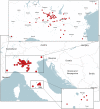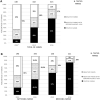A recent view about encephalomyocarditis virus circulating in compartmentalised animal population in Northern Italy
- PMID: 36631510
- PMCID: PMC9834260
- DOI: 10.1038/s41598-023-27828-5
A recent view about encephalomyocarditis virus circulating in compartmentalised animal population in Northern Italy
Abstract
Encephalomyocarditis virus (Picornaviridae, Cardiovirus A) is the causative agent of the homonymous disease, which may induce myocarditis, encephalitis and reproductive disorders in various mammals, especially in swine. Despite the disease occurred endemically in pig farms since 1997, the recent increase of death experimented in Northern Italy prompted to furtherly investigate the evolution of the virus and the actual spread of the infection. Italian EMC viruses, collected between 2013 and 2019, showed an overall antigenic stability. The in-house ELISA Monoclonal Antibodies based, able to reveal changes in seven different antigenic sites, showed only sporadic and occasional mutations in considered samples and the subsequent phylogenetic analysis confirmed antigenic panel's remarks. All the isolates could be classified within a unique lineage, which comprise other European strains and confirm that the viruses currently circulating in Italy developed from a unique common ancestor. Despite the demonstrated stability of virus, some putative newly emerged variants were detected through antigenic profile analysis and phylogenesis. Finally, the serosurvey proved that spread of EMCV is greater than the diffusion of fatal infections would suggest, due to subclinical circulation of EMCV. It demonstrated an increase in the proportion of seropositive farms, if compared with previous data with no remarkable differences between farms with and without clinical evidence of disease.
© 2023. The Author(s).
Conflict of interest statement
The authors declare no competing interests.
Figures





Similar articles
-
Molecular analysis of encephalomyocarditis viruses isolated from pigs and rodents in Italy.Virus Res. 1998 Sep;57(1):53-62. doi: 10.1016/s0168-1702(98)00081-1. Virus Res. 1998. PMID: 9833886
-
Encephalomyocarditis in Korea: serological survey in pigs and phylogenetic analysis of two historical isolates.Vet Microbiol. 2009 May 28;137(1-2):37-44. doi: 10.1016/j.vetmic.2009.01.005. Epub 2009 Jan 6. Vet Microbiol. 2009. PMID: 19200668
-
Isolation and molecular analysis of porcine encephalomyocarditis virus strain BD2 from northern China.Infect Genet Evol. 2014 Jan;21:303-7. doi: 10.1016/j.meegid.2013.11.014. Epub 2013 Nov 28. Infect Genet Evol. 2014. PMID: 24291508
-
The complex interplay between encephalomyocarditis virus and the host defence system.Virulence. 2024 Dec;15(1):2383559. doi: 10.1080/21505594.2024.2383559. Epub 2024 Jul 27. Virulence. 2024. PMID: 39066684 Free PMC article. Review.
-
The encephalomyocarditis virus.Virulence. 2012 Jul 1;3(4):351-67. doi: 10.4161/viru.20573. Epub 2012 Jun 22. Virulence. 2012. PMID: 22722247 Free PMC article. Review.
Cited by
-
A cardioviral 2C-ATP complex structure reveals the essential role of a conserved arginine in regulation of cardioviral 2C activity.J Virol. 2024 Oct 22;98(10):e0091124. doi: 10.1128/jvi.00911-24. Epub 2024 Sep 6. J Virol. 2024. PMID: 39240112 Free PMC article.
-
Genome Sequencing of Historical Encephalomyocarditis Viruses from South Africa Links the Historical 1993/4 Savanna Elephant (Loxodonta africana) Outbreak to Cryptic Mastomys Rodents.Pathogens. 2024 Mar 19;13(3):261. doi: 10.3390/pathogens13030261. Pathogens. 2024. PMID: 38535604 Free PMC article.
-
Histone H1.2 Inhibited EMCV Replication through Enhancing MDA5-Mediated IFN-β Signaling Pathway.Viruses. 2024 Jan 24;16(2):174. doi: 10.3390/v16020174. Viruses. 2024. PMID: 38399950 Free PMC article.
-
Reemerging of Encephalomyocarditis Virus in Pigs in Brazil: Pathological and Viral Characterization.Transbound Emerg Dis. 2023 Dec 7;2023:6582778. doi: 10.1155/2023/6582778. eCollection 2023. Transbound Emerg Dis. 2023. PMID: 40303707 Free PMC article.
-
Encephalomyocarditis Virus in Non-Domesticated Species.Pathogens. 2025 Apr 20;14(4):397. doi: 10.3390/pathogens14040397. Pathogens. 2025. PMID: 40333196 Free PMC article. Review.
References
-
- Reddacliff LA, Kirkland PD, Hartley WJ, Reece RL. Encephalomyocarditis virus infections in an Australian zoo. J. Zoo Wildl. Med. 1997;28(2):153–157. - PubMed
Publication types
MeSH terms
LinkOut - more resources
Full Text Sources

